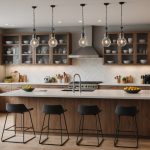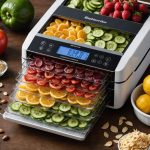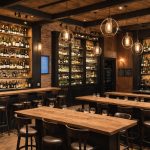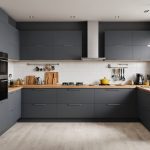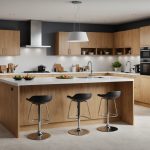Creative Modular Kitchen Concepts
In today’s homes, modular kitchen design has gained popularity for its blend of style and practicality. Among the contemporary kitchen styles, a few stand out due to their innovative use of materials and clever layouts. These modular kitchen designs often employ clean lines and efficient storage solutions, creating a seamless and functional space.
One key feature in these designs is the variety of unique kitchen layout ideas available to homeowners. For instance, an L-shaped layout not only maximizes corner spaces but also provides ample room for movement. The U-shaped design, on the other hand, is ideal for larger spaces, allowing for multiple work zones and additional storage.
In parallel : Unlocking uk building regulations: the ultimate resource for your kitchen makeover journey
Integrating aesthetic elements into functional designs can truly transform a kitchen space. For example, open shelving can add a modern touch while ensuring everyday items are easily accessible. Furthermore, using a combination of matte and glossy finishes can highlight certain areas, making the kitchen both a practical workspace and a delightful visual experience.
When planning your next kitchen renovation, consider these modular kitchen designs alongside various kitchen layout ideas to craft a space that is both stylish and functional. Tailoring the design to your needs ensures that the heart of your home remains inviting and efficient.
Also to discover : Transform your kitchen with bamboo: embrace sustainable style and unmatched benefits
Practical Tips for Seamless Upgrades
Upgrading your kitchen does not have to be an overwhelming task. With the right kitchen renovation tips, you can execute a modular upgrade efficiently. The process begins with detailed planning. Assess your current kitchen space, taking note of areas needing enhancement and set clear objectives. Consider space functionality and aesthetics, aligning your plan with available resources.
A step-by-step approach is advisable. Begin by identifying essential elements such as countertops, cabinetry, and appliances. Prioritise improvements that align with your lifestyle. For instance, a cooking enthusiast might benefit from expanded worktops or additional storage, making your modular kitchen upgrades more personalised.
Cost-effective solutions can streamline your renovation without compromising on quality. Focus on renovating rather than completely revamping. Simple changes like repainting cabinets or replacing outdated handles can bring a fresh look on budget. Prioritise spending on high-use areas for a significant impact with minimal cost.
For those inclined towards a hands-on approach, DIY kitchen enhancements offer a chance for personal expression. Painting, tiling, or even assembling cabinet units can be tackled with a bit of guidance, adding a custom style. This keeps costs down while giving your kitchen a unique, tailored touch.
Materials and Finishes for Modern Kitchens
Selecting the right kitchen materials is crucial for both durability and aesthetics in modern kitchens. Let’s explore popular materials commonly used in modular kitchens. Quartz countertops are favoured for their resistance to stains and scratches, making them ideal for busy kitchens. They provide a sleek, polished look that enhances modern aesthetics.
When considering cabinetry options, solid wood remains a classic choice. It offers durability and a timeless appeal, but tends to be pricier. Alternatively, MDF (Medium-Density Fibreboard) with a veneer finish provides a cost-effective solution without compromising on style.
Modern kitchen finishes play a pivotal role in transforming spaces. High-gloss finishes can make smaller kitchens appear larger by reflecting light. However, they might show fingerprints more easily. In contrast, matte finishes offer a subtle, sophisticated look, concealing smudges and scratches effectively.
Innovative finishes such as nano-coatings provide additional protection against daily wear and tear. These coatings enhance the longevity and preservation of kitchen surfaces, merging functionality with cutting-edge technology. Selecting the right combination of materials and finishes is key to crafting a kitchen that stands the test of time, both in utility and visual appeal.
Overcoming Common Challenges in Kitchen Revamps
Renovating a kitchen, while exciting, can present various kitchen renovation challenges. Identifying these common obstacles is crucial for a smooth process. One typical hurdle is inadequate planning, which often results in design pitfalls. For instance, insufficient storage can lead to clutter, hindering the kitchen’s functionality. Address this by incorporating innovative kitchen layout ideas such as using vertical space or installing pull-out shelves, optimising both space and accessibility.
Strategic planning can help avoid these design mistakes. Begin with a detailed assessment of your kitchen’s current layout and flow. Prioritise improvements based on your needs, focusing on high-traffic areas and essential functions. Using a checklist can ensure all aspects, from cabinetry options to electrical setups, are thoroughly reviewed.
Effective solutions for maximizing space and budget often lie in integrating multi-functional elements. Consider modular designs that double as storage and preparation areas. Opt for adjustable shelving or contemporary kitchen styles that quietly blend aesthetics with functionality. These features not only enhance utility but add a sophisticated touch to your kitchen.
Ultimately, embracing flexibility and forethought in your renovation plans can transform potential challenges into rewarding opportunities for innovation and style.
Inspiring Visuals and Case Studies
Delve into the world of modular kitchen examples to spark imagination and creativity. Exploring successful renovation case studies underscores how strategic design transforms any space. Each case reveals the nuances of effective planning and execution. For instance, a once-congested kitchen might emerge as an expansive, airy area after a thoughtfully crafted upgrade. This highlights how meticulous kitchen design photography conveys the journey from conception to completion. By studying these visual narratives, one gains insight into blending practical solutions with chic aesthetics.
Inspiration often stems from the interplay of colour and light in these designs. Light-coloured cabinets paired with luminous under-cabinet lighting can create an illusion of spaciousness. Dark accents, meanwhile, bring depth and sophistication. Observing how different hues and lighting enhance functionality and appeal aids in crafting one’s personal space.
These modular kitchen examples serve as a testament to the impact of innovation and meticulous attention to detail. They encourage incorporating diverse materials, cleverly utilising natural and artificial lighting, and experimenting with styles to match personal tastes. By learning from others’ success stories, anyone can approach their kitchen renovation with confidence and creativity, knowing they too can achieve stunning results.
Budget-Friendly Modular Kitchen Solutions
Creating a budget kitchen design doesn’t mean sacrificing style or functionality. Start by setting a realistic budget. Break down your expenses into categories such as materials, labour, and appliances, ensuring each component aligns with your financial limits. This approach not only aids in planning but also helps in avoiding unnecessary expenses.
Opt for affordable upgrades by selecting cost-effective materials. For instance, laminate countertops offer a sleek look at a fraction of the cost of stone. Similarly, stock cabinetry purchased in standard sizes can significantly reduce expenses compared to custom-made options. These choices deliver style without breaking the bank.
Finding cost-effective kitchen solutions involves focusing on high-impact areas. Invest in quality fixtures for long-term durability yet seek budget-friendly alternatives for less critical features. This ensures your kitchen remains both practical and appealing over time.
Explore options in lighting, an often-overlooked yet transformative aspect. LED under-cabinet lights are a budget-friendly way to enhance ambience and functionality. Moreover, incorporating multipurpose furniture can maximize space and utility without additional costs.
Prioritizing spending, leveraging budget-friendly materials, and investing in key elements ensures a modular kitchen design that meets both financial and functional needs. With careful planning, creating an inspiring space on a budget is entirely achievable.



